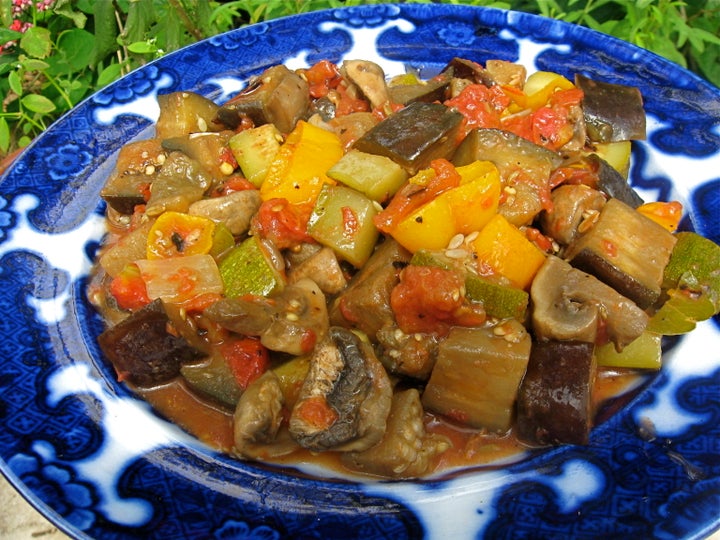
"From Malawi to Michigan, people and organizations are building better ways to eat today so that all of us can eat well tomorrow," says food activist and author Raj Patel. "This knowledge demands to be shared and spread." With "Hoops Dreams" director Steve James, the "Stuffed and Starved" author is working tell some of these success stories with their project Generation Food.
In meatcentric Cuba ("Worst. Food. Ever," writes Patel), Generation Food gives voice to meatless chef Tito Nunez Gudas, whose vegetarian restaurant El Romero shows fellow Cubans a healthy, delicious way to live and eat. In cooking workshops, he brings children into the kitchen and teaches them the vegetables they've never eaten are delicious. Dishes like lotus blossom ceviche make luscious use of local produce.
I heard almost a thousand other great stories at the sixth annual Farm to Cafeteria Conference in Burlington, Vermont, where 900 people -- urban farms, food banks, community supported agriculture, school gardens and food service, high-end chefs and school line lunch ladies (or, as some call themselves, nutrition magicians) gathered to come at the same problem -- our broken food system -- from every angle. That's where I met Navy veteran Kelly D. Carlisle. A 2011 Bon Appetit Good Food Fellow, Carlisle grew up in Oakland. That's where she started Acta Non Verba in 2010. Not only does her urban youth farm give over 200 underserved children access to fresh produce, it builds community in a city better known for crime. "Since building our farm, I've noticed an excitement and joy in the children we serve," says Carlisle. "They love to water and nurture the plants and harvest directly out of the garden, to take home food and become better providers for their families."
Look, I won't lie -- our food system has serious flaws including factory farming, GMOs, climate change, pollution, big ag, SNAP cuts, labor abuse, waste, obesity, hunger and E. coli breakouts -- complicated issues with complicated solutions. "We have tended to see these issues as black and white," says Doug Boucher of the Union of Concerned Scientists. "Often, they get oversimplified and details get lost." Worse, we can't count on government to help us fix things.
Since the advent of big ag, "you've had problems being able to speak out about food issues," says Boucher, UCS' Director of Climate Research and Analysis. "It may have gotten a little tougher in recent years. People are paying more attention to what they eat. The industry feels even more threatened and tends to lash out."
But every time big ag tries to shut us down -- or shut us up -- more people join together at the front lines of our food system. We're not talking pundits or so-called experts, we're talking about people who dedicate themselves to growing food and feeding people every day. Generation Food aims to tell some of their stories. So do I. "I think it helps to appeal to people through a message that seems a little different, that they can't immediately dismiss and say, 'I've heard that before,'" says Boucher.
It is time to speak out. It is time to listen. It is time to act. Access to fresh, healthy food is a basic human right. It's going to take basic human action to make it happen, with all of us working, caring, growing food, sharing our stories and sharing the food at our tables.
The stories I've been hearing convince me we can fix our food system. We may be separate ingredients, but we can all come together like a spicy, sustaining stew. That's my story and I'm sticking to it.
RatatouilleRatatouille, speaking of spicy, sustaining stew, is what summer tastes like. Stop by your farmers market for a haul of the season's greatest hits -- firm eggplant, skin as glossy as patent leather, verdant, vibrant zucchini, sweet, shapely pepper, tomatoes ripe to the verge of collapse, fresh, pungent onion and garlic. I like to include mushrooms in my ratatouille. They add an earthy element, a low note that chimes together with the other vegetables for a symphony of flavors. Slow-cooked, ratatouille can be stewy, silky and decadently oily, with the vegetables diced small and all but vanishing into a happy sort of sludge. Or you can do it my way, so the ratatouille is gutsier, more about texture, with chunkier vegetables taking center stage. The whole thing is delicious and doable in under half an hour. Ratatouille is a treat hot, cold or at room temperature. It tastes good the day you make it, tastes even better tomorrow.
1 tablespoon olive oil
8 ounces mushrooms, sliced
3 cloves garlic, chopped
2 tomatoes, chopped (or 1 15-ounce can chopped tomatoes)
1 sweet pepper -- red, yellow or orange, chopped
1 medium onion, chopped
1 teaspoon cumin
1 medium eggplant, chopped
1 teaspoon fennel seeds
1 large zucchini (or two small), chopped
1/2 cup red wine
1 dash red pepper flakes
sea salt to tasteIn a large pot, heat oil over medium-high heat. Add chopped garlic, giving it a stir. Add chopped onion and cook till vegetables soften and release their fragrance, about 5 minutes. In order, add chopped eggplant, pepper, zucchini and mushrooms.
Stir to combine.
Stir in chopped tomatoes, wine, pepper flakes and fennel seeds. Reduce heat to medium and cover, letting the mixture simmer for 20 minutes.
Stir again and season with sea salt to taste.
Serves 4, doubles like a dream, keeps covered and refrigerated for several days.
